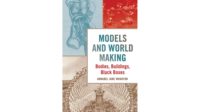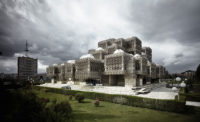The same impulses that energized abolition and labor activism in the 1830s and 1840s produced a set of reformers in subsequent decades more interested in inward or individually oriented ideas, often expressed through unconventional architecture or realized in experimental communities. To convince Americans to join their causes, these reformers published plans of hexagonal, octagonal, and circular buildings and towns designed to shape more just or healthier living—or so they argued. These reformers included Orson Fowler, a leading phrenologist; Henry S. Clubb, who started the Kansas Vegetarian Settlement Company; and spiritualists Simon Crosby Hewitt and John Murray Spear, whose ideas arrived from the other side of the living-dead divide.
Discounting them as amusing dissidents or cranks has been a mistake. Irene Cheng, associate professor of architecture at the California College of the Arts, devotes overdue scholarly attention to several of these radicals and their architectural and urban visions in an illuminating book, The Shape of Utopia. Cheng’s thesis is that the drawings produced for what she describes as “geometric utopias” solidified amorphous ideas and served as a vital tool of argument and publicity, or “visual rhetoric.” Many reformers “believed illustrations had a unique power to sway viewers by cutting through the printed word and speaking directly to hearts and minds,” she writes.
There was much that needed fixing in the new nation. With the developing market economy, harsh industrial working conditions, and well-defined class divisions, reformers tended to focus on land ownership and equitable commerce and commercial transactions. Clubb’s vegetarian, antislavery, octagon-shaped colony in Kansas drew more than 70 families to sign up, with the first arriving in 1856, Cheng writes. He represented it in diagrammatic plans, showing a town with a central park, eight radiating avenues, and subdivided wedge-shaped lots. The experiment was to be a community of “sociality without socialism,” Cheng explains, distinguishing it from other experimental communities that reflected Marxist principals.
In addition to enthusiastic dissemination of critical ideas and theory, the utopians used a certain amount of disingenuous conning and humbug in luring people out to remote places. Clubb, for example, while acknowledging in 1856 some possible inconveniences of the settlement, located on Osage tribal land, nevertheless promoted it as a can’t-miss near-paradise surrounded by an abundance of natural resources. Instead, as Cheng shows, “not a house [was] to be seen,” according to arriving community member Miriam Davis Colt. The ground was too wet, and a promised river, an important source of power, was barely a creek. “Colt’s family headed back east after months of fever, theft, rattlesnakes, and other calamities,” Cheng writes, but Colt’s husband and young son died before reaching home.
As an academic work, Cheng’s thesis and findings may be too exhaustively contextualized for a reader concerned only with the basics of U.S. utopianism and architecture. But the book’s variety of architectural plans, historical drawings, photos, advertising circulars, and even phrenological charts, provides a deeper understanding beyond the wacky futility of the colonizing experiments or the very real limits and problems of non-rectangular homes and buildings.
As Cheng shows, ideas follow unpredictable trajectories. For example, Fowler promoted octagonal houses, many of which still stand, as efficient enclosures without tight corners and full of sunlight and fresh air. Whether an owner was actually convinced of the octagonal house’s advantages, or was a faithful devotee of Fowler’s phrenological “science,” such houses could also serve as a conspicuous signaling of an owner’s individuality or independent mind.
Cheng contends that the complex legacy of utopian thought and 19th-century architectural experimentation includes Ebenezer Howard’s garden city planning—not typically thought of today, she writes, as utopian or radical. She notes as well that some critics over the years have condemned utopian thought, along with styles and symbols, as an aestheticization of politics that confuses “political states and communities with works of art,” or of trying to reshape society according to aesthetic ideals, instead of doing the hard work that leads to justice, equality, and liberty. And that, at its worst, utopianism culminates in authoritarianism or fascism. But Cheng points out the difference between conflating art and forms with politics itself, arguing that the geometric utopias enabled “at least some Americans in the 19th century to interrogate their world critically and visualize its hidden structure so that they could begin to remake it.”
The tradition of envisioning a better world, and its physical shape and buildings, is long. Thomas More’s purely fictional Utopia, with its implied criticism of his world, which briefly describes imagined towns with streets “twenty feet broad” and “buildings so uniform that a whole side of a street looks like one house,” was first printed in 1516. Cheng’s exploration of less well-known attempted utopias from the 19th century is not intended as the final word on such visions, but it is a valuable new account of the role of architectural drawing in the reformer’s mind and work.





Post a comment to this article
Report Abusive Comment